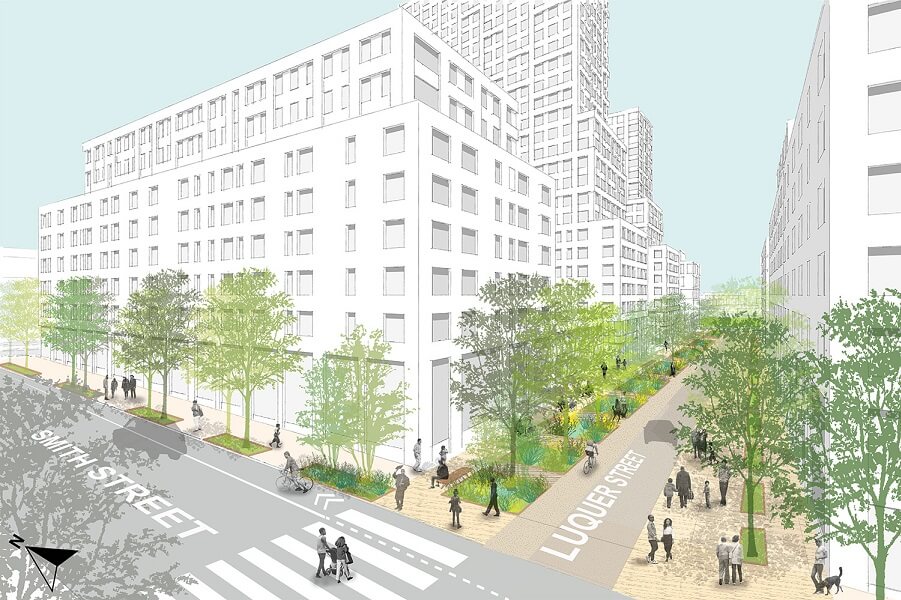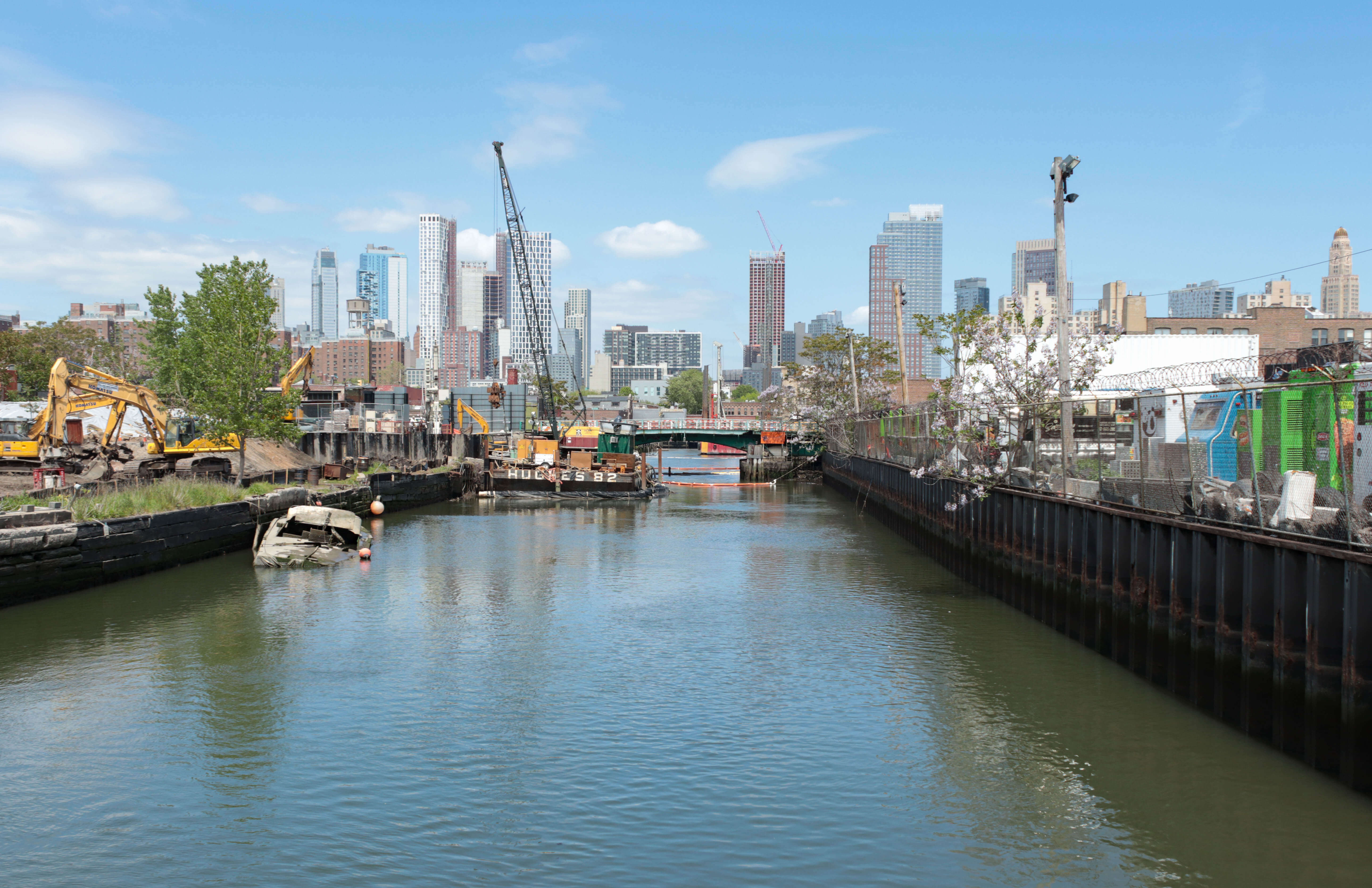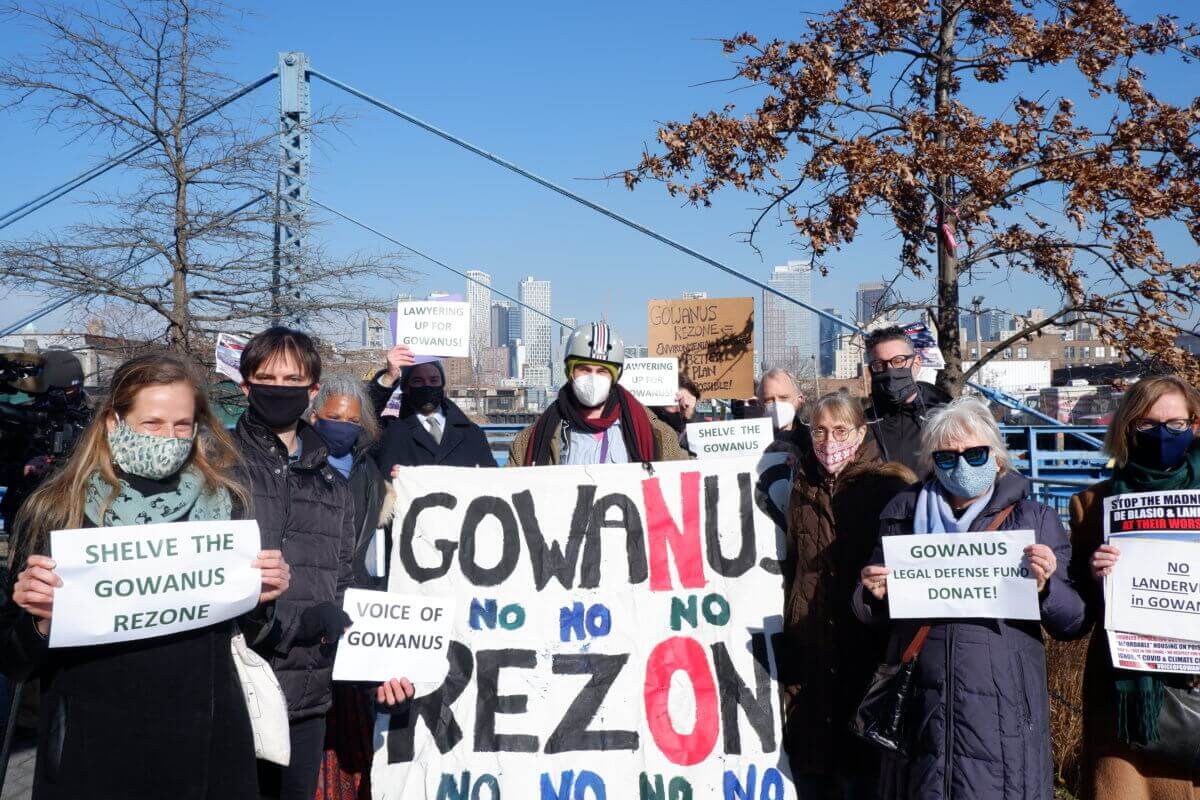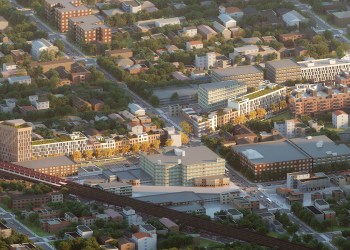Judge Stalls Controversial Gowanus Rezoning With Temporary Restraining Order After Locals File Suit
Opponents of the Gowanus rezoning sued the city Friday, alleging the Department of City Planning’s virtual Zoom hearings don’t allow for enough public review for the neighborhood-wide land use changes.

Local blogger Katia Kelly speaks out against the Gowanus rezoning at the Carroll Street Bridge on January 12. Photo by Kevin Duggan
The kickoff of the public review process for the controversial and long-in-the-works rezoning of Gowanus has been temporarily halted until at least January 27.
Opponents of the Gowanus rezoning sued the city Friday, alleging the Department of City Planning’s virtual Zoom hearings don’t allow for enough public review for the neighborhood-wide land use changes, and Brooklyn Supreme Court Judge Donald Kurtz issued a temporary restraining order on the rezoning the same day.
“When you’re dealing with a massive project of this scale that is going to impact so many people’s lives, the community must have its voice heard; that is simply not possible with virtual public hearings,” said attorney Jason Zakai on behalf of the plaintiffs, which include anti-rezoning group Voice of Gowanus, in a January 15 statement. “There are detailed, step-by-step rules laid out in City law on how to conduct the public review process. They are there for a reason, and the City must follow them, even if that means waiting until the pandemic is over.”
The city had been scheduled to officially certify the Gowanus rezoning on Tuesday, January 19, kicking off the roughly seven-to-nine-month public review process.

The coalition of local advocacy groups and residents opposed to the Department of City Planning’s neighborhood overhaul — known as the Gowanus Neighborhood Plan — said remote Zoom-based meetings violate city public meeting laws and that the city failed to give the community proper notice. The petition also alleges that the lack of notice and in-person hearings also violate their First Amendment rights to free speech and Fourteenth Amendment guarantee of due process.
The cadre of opponents includes groups that have long been opposed to the city’s plans to allow tall residential buildings in low-slung area, such as Friends and Residents of Greater Gowanus (FROGG) and Voice of Gowanus, as well as residents of the area Linda Mariano, Marlene Donnelly, Ann Kathrin Kelly, and Margaret Maugenest.
Zakai and his employer — law firm Hiller PC, which on Twitter bills itself as “protectors of the little guy” — previously worked on behalf of homeless shelter residents in Manhattan’s Lucerne Hotel, successfully getting a judge to temporarily block the city’s efforts to move the unhoused out.
“It is apparent that Respondents [the city] are attempting to rush their own application through the ULURP process now, and exploiting the situation created by the pandemic, ostensibly to limit the anticipated opposition and objections by community members to this controversial and far-reaching proposal,” the legal filings read.
If approved, the rezoning would allow new development of apartment towers rising between 22 and 30 stories along with new open and commercial spaces in the low-rise neighborhood along the highly polluted Gowanus Canal — bringing with it some 8,200 new housing units over the next decade-and-a-half, including 3,000 of them earmarked as “affordable” tied to residents’ incomes.
The canal is currently also undergoing a roughly decade-long Superfund cleanup managed by the federal Environmental Protection Agency.

The city has been attempting to rezone the area for more than a decade. Supporters of the plan said the groups were simply trying to stop a proposal they didn’t like.
When Mayor de Blasio resumed ULURP in September after a pandemic-related pause, the city began holding meetings on web-conferencing platforms. City law states that those gatherings must be held at a “convenient place of public assembly” in the district or borough — and the plaintiffs claim that hearings via platforms like Zoom violate that law.
However, Governor Cuomo has also issued a state-wide executive order allowing public hearings to move online to ensure they can continue amid the pandemic.
The plaintiffs argue that virtual hearings don’t allow for the same methods of holding public officials accountable, such as bringing along signs or wearing t-shirts in protest, applauding or booing, and speaking freely — as opposed to webinars where operators have the power to choose who gets to speak and can cut their mics at any time.
On the other hand, proponents of the rezoning note that online meetings actually allow for greater participation from locals, as Brooklynites are no longer forced to trek to a physical location for hours on a weeknight. One member of CB6 labeled the lawsuit as “NIMBY” — an acronym standing for “Not in My Backyard” — and “shockingly thin.”
A spokesman for de Blasio’s office also countered their assertions, arguing that virtual meetings were in fact legal and that the city’s three meetings about the Gowanus rezoning this fall saw some 200 or more attendees each.
“Virtual meetings aren’t just legal and obviously appropriate in a pandemic – they have increased participation and opened the process to those unable to attend in-person,” said Mitch Schwartz in a statement. “We look forward to winning this case, beginning certification, and delivering a rezoning proposal New York City can be proud of.”
In virtual info sessions at the end of 2020, opponents repeatedly called on the city to halt the rezoning, saying officials used Zoom to control and muzzle critics of the plans, and that virtual meetings didn’t cut it for such a large scheme.
Apart from the pandemic, the city’s rezonings have recently come under fire from neighborhood groups in Sunset Park, Bushwick, and across the city, who argue that the process favors developers over residents and leads to gentrification.

The Gowanus Neighborhood Plan is the last neighborhood-wide rezoning under the de Blasio administration and covers 80 blocks around the noxious Gowanus Canal, roughly bounded by Bond Street, Baltic Street, Fourth Avenue, and Huntington, Third, Seventh, and 15th streets.
In addition to the virtual meeting shortcomings, critics of the plan raised concerns of environmental safety of building big along the toxic canal, especially the fully affordable housing complex at Public Place, also known as Gowanus Green, which is slated for a heavily polluted former gas manufacturing site.
Editor’s note: A version of this story originally ran in Brooklyn Paper. Click here and here to see the original stories.
Related Stories
- Locals Opposing Gowanus Rezoning Prepare for Potential Legal Fight
- Public Review Process for Gowanus Rezoning Set to Begin in January
- Gowanus Residents Want to Halt Rezoning Until in-Person ULURP Meetings Can Resume
Sign up for amNY’s COVID-19 newsletter to stay up to date on the latest coronavirus news throughout New York City. Email tips@brownstoner.com with further comments, questions or tips. Follow Brownstoner on Twitter and Instagram, and like us on Facebook.









What's Your Take? Leave a Comment